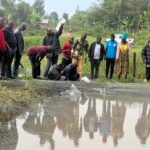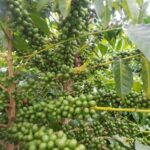A conversation with Sumitra Devi: the regenerative agriculture pioneer
Authors: Akanksha Mishra (PRADAN), Meghna Mukherjee (MetaMeta Research), and Marina Vara Gutiérrez (Aidenvironment).
Meet Sumitra Devi. She hails from Chatugada village in the Bokaro district of Jharkhand. Since 2007, PRADAN started promoting self-help groups (a self-help group is an intermediary financial institution usually composed of 12 to 25 local women. The main idea was to ease access to credit and finance) in Sumitra’s village. PRADAN has promoted a total of 7 self-help groups (SHGs), and she was part of one SHG namely Jiyad Jharna Mahila Mandal.
She says, “My husband, Naresh Manjhi, and I have been cultivating paddy and maize in the Kharif season (June/July to September/October) and growing potato in the Rabi Season (October/November to January/February) in the 60 decimal[1] of land that we own. After receiving training from PRADAN on better agricultural practices, we have started growing different crops like tomato and brinjal during the Kharif season”.
Planting new crops has resulted in an increase in their income which has boosted their confidence to experiment with the farming of other crops. From 2007 to 2021, Sumitra Devi and her family invested their time in growing different kinds of crops. During all those years, one lesson which stuck with her was how the use of chemical pesticides and fertilizers was decreasing the soil quality of their land. To understand the steps she can undertake to revive the soil quality she connected with PRADAN officials who organized a village demonstration on preparing organic fertilizers and associated crops by adopting the principles of regenerative farming. These new activities, in addition to the installation of solar pumps which secured access to water, helped in tackling the problems farmers were facing due to the use of chemical fertilizers and pesticides.
After gaining confidence, Sumitra Devi with the support of her husband set out to experiment with new activities like multilayer farming. “In the Kharif season, my husband and I decided to pursue multilayer farming in 10 decimal of land by cultivating bottle gourd and radish”. However, the process of setting up a multilayer plot was not easy. Sumitra Devi had to make some initial investments like purchasing nets, poly wire, and new seeds to put into the multilayer structure. She also started purchasing organic inputs from the OPU unit (a smaller version of the Bio-Resource Centre where all the organic inputs are locally prepared)to apply to the crops established in their own village. She applied Jeevamrita and Dhanjeevamrita (liquid organic fertilizers) for growing gourd and radish, and at an interval of every ten days, she used Agniastra and Brahmastra (organic pesticides for chewing pests) to protect the crops from pests. She says that to protect the crops and as a safety precaution she used Nimastra (an organic pesticide for sucking pests) on their land. All these organic inputs started showing a positive result from the beginning.
The installation of the multilayer system has been a success for Sumitra. Despite the high rainfall over the last season, she harvested gourds 15 times in 3 months. She was able to sell a total of 600 kg of gourds from which she earned Rs. 18.000. Radish was more affected by the changing weather conditions, but she still managed to earn an additional income of Rs. 20.000 from radish. This additional money helped Sumitra Devi to continue improving and investing in her farm.
Boosted by her initial success, Sumitra wants to continue innovating by practicing new techniques and growing new crops. This Rabi season, she plans to grow beans and bottle gourd on her multi-layer farm. She has also planted papaya plants around her multilayer farm as a boundary. The papaya plant will act as a windbreaker and also provide shade to the crop apart from the financial return on it. She is also excited that the leaves from the papaya plant will help her prepare organic pesticides at home and will also be consumed by the family: leading to a healthy life.
Sumitra concludes; ‘Since I started practicing regenerative farming I produce more crops on the same piece of land, I am earning more money and I am protecting the soil fertility of my land’.
[1] 1 decimal is equal to 1/100th of an acre



